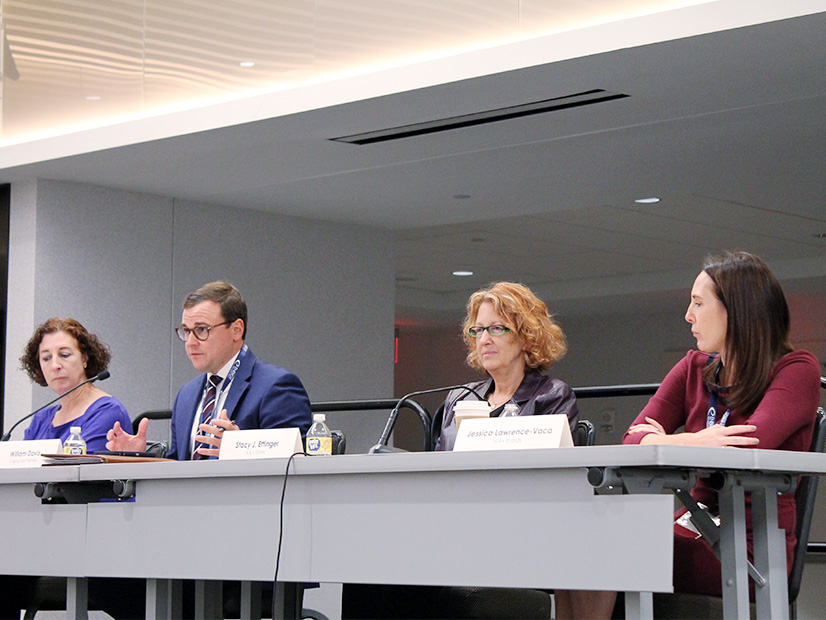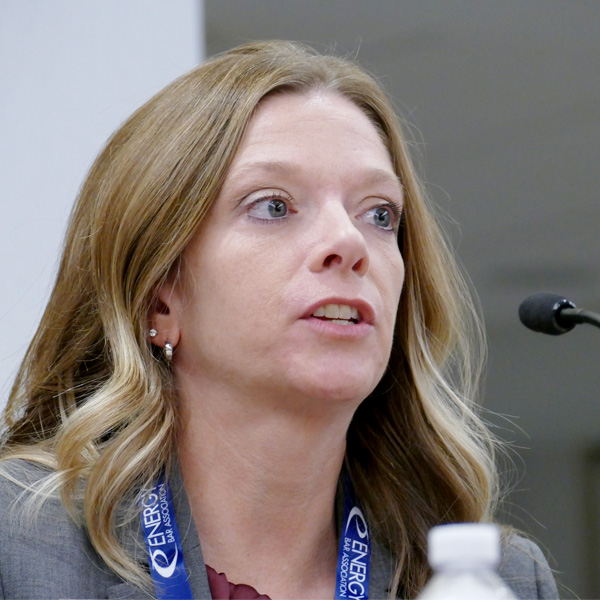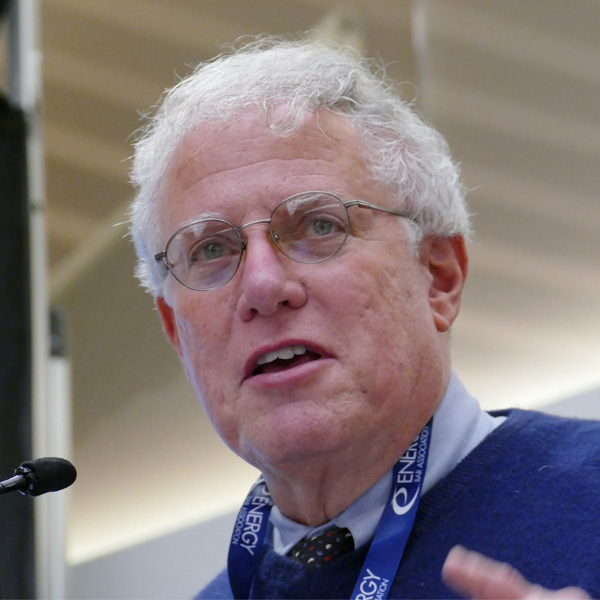WASHINGTON — The Energy Bar Association last week held its annual Mid-Year Energy Forum over two days at the Renaissance Downtown Hotel to discuss the latest developments in energy law, including West Virginia v. EPA, the Inflation Reduction Act, supply chain issues and hydrogen regulation, among many other topics.
Here is some more of what we heard. (See related stories, W.Va. v. EPA Ruling: ‘Nuclear Bomb’ or ‘Speed Limit’?, Lawyers, Industry Debate Path for Hydrogen Regulation and Can New Revenue Models Unlock Interregional Transmission?.)
Excitement About IRA — but also Trepidation
Panelists expressed enthusiasm about the Inflation Reduction Act, even as they acknowledged its limitations and the significant amount of work it will take to implement it.
The law provides for about $370 billion in funding for clean energy technologies, including electric vehicles and energy storage, making it the most significant piece of legislation passed by the U.S. to address global climate change. But the bill, originally called the Build Back Better Act, was considerably pared down from trillions in incentives and passed via congressional budget reconciliation to avoid a filibuster by Senate Republicans.
Because of the way it was passed, the IRA “deals only with the opportunity to provide — and very substantial, but still — loans, grants and tax incentives,” Jim Wrathall, general counsel for New Energy Equity, said during the forum’s opening general session on Wednesday. It is “using policy solutions that are not market-based; they’re not comprehensive; and they’re not aimed at targets. They’re money upward. We have to build using these tools and make sure they’re successful.”
“It’s really going to be a renaissance in our domestic manufacturing,” said Edward Hild, principal of government relations for Buchanan Ingersoll & Rooney. “I think that’s where this ultimately leads: to manufacturing [on a scale] we have not done here before. … There’s really a desire not to be dependent on China and other countries, and to do things here.”
“We in this room and in this industry have a challenge here,” Wrathall said. “We’re in the first inning with the tools that are being made available. … We have a job to do to make sure we don’t have missteps.” He reminded the audience of Solyndra, the solar panel manufacturer that went bankrupt after receiving loans from the Obama administration and became a talking point for Republicans against renewable energy.
That’s creating a lot of pressure on not just the industry and its lawyers, but also on the Treasury Department, which needs to issue the regulations and guidance for how the law will be administered. Though $28 billion in investments have already been committed as a result of the law, according to Wrathall, speakers during a different panel the next day noted that it left many aspects, such as definitions, for Treasury to decide.
 From left: Vanessa Sciarra, American Clean Power Association; William Davis, Capitol Tax Partners; Stacy Ettinger, K&L Gates; and Jessica Lawrence-Vaca, SOLV Energy. | © RTO Insider LLC
From left: Vanessa Sciarra, American Clean Power Association; William Davis, Capitol Tax Partners; Stacy Ettinger, K&L Gates; and Jessica Lawrence-Vaca, SOLV Energy. | © RTO Insider LLC
“I cannot overstate how significant an undertaking this is going to be for the Treasury Department,” said William Davis, a partner with Capitol Tax Partners. “A lot of it are issues of first impression for the Treasury Department; the tax writers in that building and in the IRS. …
“I looked at the Tax Cuts and Jobs Act of 2017; it took three to four years to get all the guidance out on that bill, and [for some aspects], the guidance is still coming out. … So it’s going to be a long process.”
Forced Labor
Also on the panel with Davis was Stacy Ettinger, a partner with K&L Gates, who spoke about the numerous actions taken by the U.S. government by both the Trump and Biden administrations against foreign manufacturers, mainly in the form of tariffs on products shipped from adversaries.
They include the Commerce Department’s investigation into alleged dumping of solar components by China to avoid U.S. tariffs, launched in March. (See Solar Sector Braces for Tariff Probe Impact.)
 Former ERCOT CEO Bill Magness | © RTO Insider LLC
Former ERCOT CEO Bill Magness | © RTO Insider LLC
Also impacting trade with China is the Uyghur Forced Labor Prevention Act, signed by President Biden late last year. The law assumes that certain goods manufactured in China’s Xinjiang province were done so using forced labor, unless U.S. Customs and Border Protection can certify that they were not. The Chinese government is widely suspected of holding Uyghurs, an ethnic minority in the country, in internment camps and using them as slaves.
The law also requires firms outside of Xinjiang to disclose any ties with companies within the province. However, Ettinger said, China has laws that penalize its own companies for complying with what it perceives as the imposition of foreign policy.
“So Chinese suppliers are in a rough spot,” she said. “They cannot agree to language [in a contract] that talks about certification against the use of forced labor because China’s position is, there is no forced labor in China.” Many Chinese suppliers are now refusing to sign contracts for trade with the U.S. “and would rather deal with Europe.”
Ettinger said lawyers should advise their clients to “fix the language [in the contracts.] Don’t talk about forced labor … because the suppliers won’t be able to do it. If they do take that step, the Chinese companies are at risk of action against them. … They’d rather deal with somebody else who doesn’t worry about these issues.”
Transmission’s Moment
 Michael Skelly, CEO of Grid United | © RTO Insider LLC
Michael Skelly, CEO of Grid United | © RTO Insider LLC
Michael Skelly, founder and CEO of Grid United, marveled at the attentiveness of the audience at his panel discussion Oct. 11.
“It may be that this is because transmission is one of the most legally intense aspects of the energy transition. Or as we say — ruefully — in our company, ‘No lawyer left behind,’” he said. “Or maybe we’re just having a moment with transmission. … Transmission was in Esquire magazine. Come on.” Esquire’s article was titled, “The Sexiest Part of the Clean Energy Transition Is Big-Ass Power Lines.”
75 Texts an Hour
Former ERCOT CEO Bill Magness, now senior principal consultant for DNV, recounted that at the peak of February 2021’s — “the largest controlled outage ever seen” — he was receiving about 75 texts an hour. “And most of them were just, ‘You suck!’” he joked.
Talking to the Right People
 NERC General Counsel Sônia C. Mendonça | © RTO Insider LLC
NERC General Counsel Sônia C. Mendonça | © RTO Insider LLC
NERC General Counsel Sônia C. Mendonça said the organization is seeking to broaden whom it talks to.
“One of the things that we continuously ask ourselves at NERC is, ‘Are we doing the right outreach? Are we doing enough outreach?’ The risks in the bulk power system are more and more coming from outside of the bulk power system. So if we continue to talk to ourselves, that’s not going to be a very successful conversation, in terms of mitigating that risk. So we need to expand … constantly to states, other critical infrastructures. And we are always asking ourselves, ‘Who is not at the table?’”
Emergency Planning
 Angela Kolar, Colonial Pipeline | © RTO Insider LLC
Angela Kolar, Colonial Pipeline | © RTO Insider LLC
Angela Kolar, chief risk officer of Colonial Pipeline, said her company moved several years ago to use its incident command structure for any kind of emergency. But company officials couldn’t have anticipated the ransomware attack that led it to shut down its gasoline pipeline system in May 2021.
“When you go to your crisis management team, and you have a scenario that [includes] a nationwide pandemic and nobody is working from the office and you have a cyberattack at the same time, people want to ask you when the aliens are invading too,” she said. “It just doesn’t seem practical, until it actually happens to you.”
Kolar said her company attempted to be as transparent as it could following the attack but had to make decisions without knowing how severe the attack was. “We didn’t know if they had gotten into our IT side and our OT side. We shut down the pipeline out of an abundance of caution, until we knew what was going on.”
PJM’s Advice for FERC
 Craig Glazer, PJM | © RTO Insider LLC
Craig Glazer, PJM | © RTO Insider LLC
Craig Glazer, vice president of federal government policy for PJM, said the RTO is “disappointed” with FERC’s “piecemeal” approach to planning, with NERC assigned to write reliability standards addressing hot and cold temperatures and extreme weather conditions listed as a factor to be considered by planners in the commission’s Notice of Proposed Rulemaking on transmission planning (RM21-17). Meanwhile, critical facilities planning, including gas-electric coordination, storm hardening and interregional transfer capability goals were not addressed, Glazer said.
“We started this as a way to reform planning, yet this aspect of planning is really piecemeal [and] chopped up. And I think we’re going to look back and say we didn’t address it comprehensively when we had the opportunity to do so. …
“Is there a role for NERC? Yes. Should we proceed to standard setting at this point? No, we don’t think that’s the right thing to do,” Glazer said. “We think we’ve got to take a holistic look at all these issues, and then develop standards rather than piecemealing standards. … We’re really asking the staff and the commissioners to step back, look at the totality of what’s going on and what you’re trying to get done.”
Glazer said PJM has three “asks” of FERC, starting with a “clear policy statement” on the importance of enhanced reliability planning to counter critics alleging RTOs are “gold plating” the system.
“Absent some direction from the federal regulator that all the planning authorities need to focus on this, I think we’re going to be in this finger-pointing exercise … forever,” Glazer said.
Second, PJM is asking FERC to give RTOs a “homework assignment” to identify the enhanced reliability needs in each region and how they plan to address them. “We don’t have that record really anywhere at this point,” he said.
Third, PJM would like FERC to work with NERC and the national labs to identify metrics for determining the minimal interregional transfer capacity.
“It’s not a number. It’s a way to analyze what’s the right level of interregional transfer capability,” he said. “I’ve had commissioners say to me, ‘Just go negotiate with your neighbor on interregional coordination.’ It doesn’t work. One system ends up leaning on another system.”
Glazer also questioned FERC’s call for long-term planning looking 20 years into the future. “Twenty years ago, the commission held a technical conference in Charleston, W.Va., to direct us to build more transmission to move coal-fired generation into Maryland and Baltimore and Washington, D.C.,” he said. “And we actually did come up with a plan to do that, which we had to withdraw. But imagine if we had built that transmission.”




